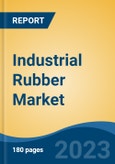Speak directly to the analyst to clarify any post sales queries you may have.
10% Free customizationThis report comes with 10% free customization, enabling you to add data that meets your specific business needs.
Key Market Drivers
Growing Demand of Industrial Rubber from Construction Industry
The construction industry represents a significant end-user of industrial rubber, utilizing it in various applications such as roofing membranes, vibration isolation systems, seals, and belts. Rubber’s ability to stretch up to 1000% of its original length and its extreme pliability - being approximately 100,000 times more flexible than steel - make it particularly suitable for dynamic applications requiring resilience and elongation. Its modulus of elasticity in compression ranges between 2 and 12 MPa, compared to around 210,000 MPa for steel, showcasing its unique mechanical properties. Rubber's flexibility, weather resistance, and insulating capabilities make it ideal for applications like expansion joints, waterproofing, and soundproofing in modern infrastructure. Moreover, growing trends in sustainable construction are driving the use of recycled rubber materials, such as crumb rubber and rubber mulch derived from end-of-life tires, due to their environmental benefits and performance efficiency.Key Market Challenges
Volatility in Cost of Raw Materials
Price fluctuations in raw materials such as natural rubber, synthetic rubber, and chemical additives pose a major challenge to the Global Industrial Rubber Market. These materials are critical to the quality and functionality of rubber products, yet their costs are heavily influenced by factors like geopolitical instability, demand-supply gaps, and disruptions in logistics. Such volatility puts pressure on profit margins and complicates pricing strategies for manufacturers, who may face the difficult choice of absorbing higher costs or passing them on to customers - potentially affecting demand. Additionally, these price uncertainties make financial planning and long-term procurement strategies more complex. To mitigate these issues, companies are increasingly adopting measures such as diversifying suppliers, integrating cost-reduction initiatives, and exploring alternative raw materials to ensure operational stability and maintain competitive positioning.Key Market Trends
Advancements in Rubber Technologies
Technological progress is reshaping the industrial rubber landscape, particularly with the development of high-performance synthetic rubbers. Materials like styrene-butadiene rubber (SBR) and ethylene propylene diene monomer (EPDM) offer enhanced durability, weather resistance, and aging stability, making them highly sought after in automotive, construction, and industrial applications. SBR is now widely used in tire manufacturing and conveyor systems due to its superior abrasion resistance, while EPDM has become a preferred material for seals and weather-stripping owing to its excellent ozone and UV resistance.Simultaneously, innovations in rubber recycling are driving a more sustainable future for the industry. Advanced technologies such as pyrolysis, devulcanization, and precision micronization are enabling efficient recycling of end-of-life rubber products, particularly tires. Pyrolysis processes convert waste rubber into valuable outputs like carbon black, oil, and metal wire, while devulcanization allows rubber to regain flexibility for reuse. These innovations not only reduce environmental impact but also contribute to raw material circularity, making recycling a core component of industrial rubber production strategies.
Key Market Players
- SINOPEC CORPORATION
- LG CHEM LTD.
- THE GOODYEAR TIRE & RUBBER COMPANY
- TOYO TIRE & RUBBER CO., LTD.
- BRIDGESTONE CORPORATION
- LOTTE CHEMICAL CORPORATION
- ARKEMA S.A.
- BRASKEM S.A.
- CELANESE CORPORATION
- UNITED RUBBER INDUSTRIES INDIA PRIVATE LIMITED
Report Scope:
In this report, the Global Industrial Rubber Market has been segmented into the following categories, in addition to the industry trends which have also been detailed below:Industrial Rubber Market, By Type:
- Natural Rubber
- Synthetic Rubber
Industrial Rubber Market, By Application:
- Automotive
- Building & Construction
- Healthcare
- Coating
- Others
Industrial Rubber Market, By Region:
- North America
- United States
- Canada
- Mexico
- Europe
- France
- United Kingdom
- Italy
- Germany
- Spain
- Asia Pacific
- China
- India
- Japan
- Australia
- South Korea
- South America
- Brazil
- Argentina
- Colombia
- Middle East & Africa
- South Africa
- Saudi Arabia
- UAE
Competitive Landscape
Company Profiles: Detailed analysis of the major companies present in the Global Industrial Rubber Market.Available Customizations:
With the given market data, the publisher offers customizations according to a company's specific needs. The following customization options are available for the report.Company Information
- Detailed analysis and profiling of additional market players (up to five).
This product will be delivered within 1-3 business days.
Table of Contents
Companies Mentioned
- SINOPEC CORPORATION
- LG CHEM LTD.
- THE GOODYEAR TIRE & RUBBER COMPANY
- TOYO TIRE & RUBBER CO., LTD.
- BRIDGESTONE CORPORATION
- LOTTE CHEMICAL CORPORATION
- ARKEMA S.A.
- BRASKEM S.A.
- CELANESE CORPORATION
- UNITED RUBBER INDUSTRIES INDIA PRIVATE LIMITED
Table Information
| Report Attribute | Details |
|---|---|
| No. of Pages | 185 |
| Published | July 2025 |
| Forecast Period | 2024 - 2030 |
| Estimated Market Value in 2024 | 30.56 Million Tonnes |
| Forecasted Market Value by 2030 | 40.72 Million Tonnes |
| Compound Annual Growth Rate | 5.1% |
| Regions Covered | Global |
| No. of Companies Mentioned | 10 |









